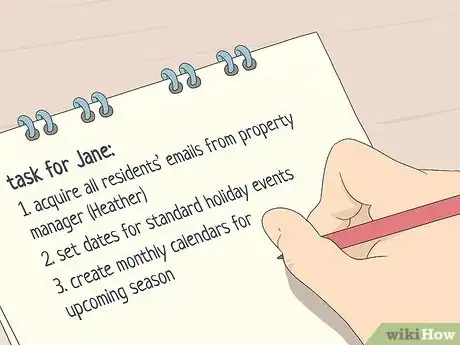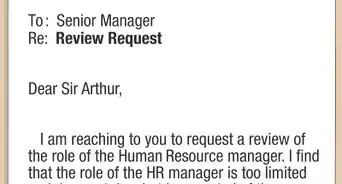This article was co-authored by Jessica Notini, JD. Jessica Notini is a Negotiation and Mediation Coach practicing in California and internationally in many Latin countries. She is also a Lecturer at Stanford Law School and an Adjunct Professor at Boalt School of Law, Hastings College of the Law, and Mills College's MBA Program. She is the past Chair of the California State Bar Alternative Dispute Resolution Committee, served as the President of the Association for Dispute Resolution of Northern California (formerly NCMA), and was a member of the Board of Directors for the Mediation Society of San Francisco. She was recognized for her leadership and years of dedication with the California Dispute Resolution Council’s 2012 Don Weckstein Award. She has a BA in Psychology from Wesleyan University and a JD from the University of Michigan.
There are 8 references cited in this article, which can be found at the bottom of the page.
This article has been viewed 13,417 times.
Dealing with passive-aggressive people can be a pain, but it can be done! It’s especially important to curb this particular problem in the workplace, where dozens of coworkers spend multiple hours a day communicating and giving feedback to one another.[1] If you’re a manager or boss, passive-aggressive employees can cause delays or hostilities in the office, so you have to understand, identify, and stop that behavior right away. Fortunately, there are some basic communication and management techniques that you can use to make your workplace run more smoothly. Provide quality leadership as soon as you identify passive-aggressive behavior to nip the problem in the bud.
Steps
Communicating with the Employee
-
1Focus on the employee’s message rather than their delivery. The passive-aggressive person may have the wrong style of voicing their problems, but in many cases, they could have a legitimate critique. While it may be difficult for you, try to ignore the passive-aggressive part of the delivery and focus on the actual message. This way, you can begin building bridges with the employee without getting angry.[2]
- Try to restate what an employee says to yourself. For example, the employee may say, “I love how you think this will work.” This is obviously a dig at you, but at its core, the statement is “I don’t think this plan will work.”
- This requires you to not take things personally, even if the employee is trying to insult you. Rise above the personal insult to get to the heart of the matter.
-
2Ask the employee to state any grievances if they act passive-aggressive. People often resort to passive-aggressive behavior when they feel like their views aren’t being heard. The employee may be trying to communicate with you, though in an unproductive way. Call the employee in and directly ask them what their complaint or critique is. Show them that you legitimately want to hear their views to get them to open up.[3]
- Don’t be accusatory or seem frustrated when you question the employee. Keep this interaction friendly and emphasize that you want everyone on the team to feel like they can talk to you.
- Passive-aggressive people usually avoid direct confrontation, so they may deny that they have any complaints initially. Press a bit harder if you have to. Say, “I ask because the comment you made in our meeting yesterday made me think you weren’t happy with some of the plan. I really want every happy, so I’d love if you could tell me what the issue is.”
Advertisement -
3Acknowledge if the person is making a good point. Sometimes, the employee’s grievance is entirely legitimate. They may have noticed issues in the plan or another employee being ineffective. Give the person credit for bringing the issue to your attention, and assure them you’ll try to fix that. Then, wait to see if their behavior improves after they feel like you’ve heard them.[4]
- Thank the employee for being open with you. End the conversation with, “Thank you for sharing that. I really appreciate your honesty. I’m going to start working on that right now.”
- Remember that if the employee makes a good point, that still doesn’t excuse their disruptive behavior. Be prepared to talk about that issue further if it doesn’t improve.
-
4Explain to the employee if their behavior is inappropriate. Passive-aggressive behavior can be disruptive or unproductive. If an employee has a pattern of this behavior, call them in for a meeting. Give them a clear explanation on what they’re doing wrong and how it’s impacting the workplace. Provide examples and suggestions on fixing the issue.[5]
- Be very specific when you bring the issue up, because passive-aggressive people often ask for evidence as a defense mechanism. Say, “You’ve missed a deadline 3 times in the past month, on these dates. This isn’t working for us. Let’s design some strategies to fix that issue.”
- Be calm and direct when you explain the issue. Say something like, “It would really help everyone out if you’d be more open about your complaints. In the future, please come to me if you’re not happy about something.”
- Avoid outright accusations of passive-aggression. The person will probably react negatively and the problem could get worse.
Managing their Work
-
1Create a clear and detailed list of tasks for the employee. If a person has a problem with completing tasks, then make sure there is no uncertainty about what you expect. A specific to-do list prevents a passive-aggressive employee from saying that they didn’t know what tasks they were responsible for. Continue presenting them with these lists until you’re sure that their behavior has improved.[6]
- Make these tasks as clear as possible. Include deadlines as well, so the employee can’t claim that they weren’t aware of them.
- Draw up some to-do lists in advance so if the employee completes one, you have another ready to go.
-
2Check in on the employee regularly when they have an assignment. If the passive-aggressive person tends to procrastinate or blow off work, keep them accountable. Once you assign them a task, make sure they stay on task with regular check-ins. Drop by and say, "I just wanted to see how this project is going. When can I expect it on my desk?" When the employee knows you'll be checking in regularly, they'll be less likely to procrastinate.[7]
- Remember to be friendly during these check-ins. Don't seem threatening or accusatory. It's just a reminder that you're expecting them to work.
- Keep in mind that the employee may resent the fact that you're suddenly checking-in all the time. Their behavior could get worse for a brief time until they adjust. Be prepared for this and maintain your composure if they give you a passive-aggressive attitude.
-
3Set clear consequences for not meeting expectations. Lack of consequences can encourage a passive-aggressive employee to continue working unproductively. When you assign them tasks, let them know that there are negative outcomes for missed deadlines or shoddy work. Try not to sound threatening – just calmly inform them that they’ll face consequences for failing to complete tasks.[8]
- Show the employee how poor work could impact their future. For example, say, “You’re up for a raise in 6 months. Poor performance will definitely impact that decision.”
- Demoting someone by changing their roles is also a possible consequence. For example, tell them, “We can always switch you back to your previous role if this job isn’t working for you.” This makes the consequence sound less threatening.
- Be prepared to follow through on any consequences you set. If you don't the employee will know they can take advantage of you.
Documenting the Employee's Behavior
-
1Keep a list of inappropriate behaviors from this employee. Passive-aggressive people often respond to challenges by saying things like “When did I do that?” If you’ve noticed a consistent pattern of bad behavior or performance, make note of it when you see it. That way, if you do have to confront the employee, you can present a list of evidence for their behavior.[9]
- For example, if the employee has a history of making insulting remarks to coworkers, note down the date every time this happens.
- Tracking the employee’s actions is also important to cover yourself if you bring the issue up to a superior. It shows that you were responsible and kept records of the situation.
- Only do this if there is a problem with an employee. Don’t keep records on every employee, or they could resent being watched and monitored.
-
2Have someone take notes in a meeting that involves the employee. Employees sometimes claim that plans weren’t finalized or a deadline wasn’t set as an excuse for not completing tasks. Avoid this risk by keeping a record of any meetings that you have with the employee. This record will show that tasks were set, directions were given, and a deadline was decided upon. If the employee claims that instructions or deadlines were vague, you can show them the notes to prove that they weren’t.[10]
- In many cases, just knowing that there’s a record of the meetings fixes an employee’s behavior. They’re now aware that you have notes and they can’t claim directions were vague.
- Consider circulating the meeting notes to everyone who was there so they can approve them for accuracy. This confirms to the employee that you have a record of the conversations and they can’t deny what was said.
- If the employee is a consistent problem, let the note-taker know that you’re especially interested in recording what you say to that employee. Make it clear that you want the record to show that you provided clear deadlines and instructions.
-
3Bring the issue to upper management if the employee persists. Unfortunately, your best efforts could still not be successful. Some employees refuse to change. In this case, you should bring the issue up to your superiors. They can help you design new strategies, talk to the employee, or consider terminating the employee if the problem persists.[11]
- Present all the evidence you have, including the instances of bad behavior you’ve noted, the to-do lists you’ve provided, and the meeting records. This demonstrates a pattern of behavior and efforts on your part to fix the situation.
- If nothing else, speaking with your upper management covers yourself from criticism if the employee’s problems are reflecting badly on you.
Being an Effective Leader
-
1Remain calm when interacting with passive-aggressive employees. The key in dealing with a passive-aggressive person is never losing your temper. They often try to push your buttons in subtle ways, so if you do lash out, you look like the aggressor and they look like the victim. Avoid this outcome by remaining calm whenever you interact with this person.[12]
- If you feel yourself losing your temper, stop and count to 10 slowly. Remind yourself that yelling or lashing out will make the situation worse, and you’ll look bad.
- Excuse yourself from the room if you need a minute to cool off.
-
2Avoid being passive-aggressive yourself to show you won’t tolerate it. Lead by example and avoid all passive-aggressive behavior. Be direct and clear when you speak with your employees. If you have a problem, state it openly rather than using sarcasm or anger. These techniques show your employees that passive-aggression is not how you solve problems.[13]
- Learn to recognize your own passive-aggressive behavior and work to stop it if it’s a problem of yours.
-
3Show employees that you’re okay with them disagreeing with you. If you’re rigid and don’t tolerate any disagreement, you could encourage passive-aggressive behavior from your employees. Show your employees that you’re open to their views and want to hear their opinions. Opening this line of communication can cut down on passive-aggressive behavior because employees know that you’re listening.[14] [15]
- Never punish or lash out at an employee for sharing an opinion. This shows the others that you don’t accept disagreement.
- If employees don’t voluntarily give their opinions, consider setting up an anonymous suggestion system where employees don’t have to worry about being shamed.
- Remember that letting employees voice their opinions doesn’t mean that you have to accept all of them. You’re still the leader and have to make decisions. Create a friendly environment for discussion and disagreement, but ultimately make it clear that the decisions are yours to make
-
4Have group meetings where everyone is free to express their opinions. Periodic meetings to let employees vent and share their thoughts are a good way to show everyone that you value communication. Either have meetings specifically for this purpose or have an “open floor” section in your normal meetings where everyone can take part. This encourages employees to be open with you and avoid resorting to passive-aggression.[16]
- Remember to follow-through on your promise that employees can express themselves. If someone shares an opinion and you laugh or dismiss them, you’re not being true to your promise.
Expert Q&A
-
QuestionHow can I communicate with a passive-aggressive person?
 Jessica Notini, JDJessica Notini is a Negotiation and Mediation Coach practicing in California and internationally in many Latin countries. She is also a Lecturer at Stanford Law School and an Adjunct Professor at Boalt School of Law, Hastings College of the Law, and Mills College's MBA Program. She is the past Chair of the California State Bar Alternative Dispute Resolution Committee, served as the President of the Association for Dispute Resolution of Northern California (formerly NCMA), and was a member of the Board of Directors for the Mediation Society of San Francisco. She was recognized for her leadership and years of dedication with the California Dispute Resolution Council’s 2012 Don Weckstein Award. She has a BA in Psychology from Wesleyan University and a JD from the University of Michigan.
Jessica Notini, JDJessica Notini is a Negotiation and Mediation Coach practicing in California and internationally in many Latin countries. She is also a Lecturer at Stanford Law School and an Adjunct Professor at Boalt School of Law, Hastings College of the Law, and Mills College's MBA Program. She is the past Chair of the California State Bar Alternative Dispute Resolution Committee, served as the President of the Association for Dispute Resolution of Northern California (formerly NCMA), and was a member of the Board of Directors for the Mediation Society of San Francisco. She was recognized for her leadership and years of dedication with the California Dispute Resolution Council’s 2012 Don Weckstein Award. She has a BA in Psychology from Wesleyan University and a JD from the University of Michigan.
Negotiation & Mediation Coach It can really help to show that you're listening to them. Try paraphrasing what they say back to them to make sure you're really understanding what they're trying to say.
It can really help to show that you're listening to them. Try paraphrasing what they say back to them to make sure you're really understanding what they're trying to say.
References
- ↑ https://www.psychologytoday.com/us/blog/passive-aggressive-diaries/201601/15-red-flags-passive-aggressive-behavior-work
- ↑ https://www.inc.com/will-yakowicz/6-rules-to-effectively-communicate-with-passive-aggressive-employees.html
- ↑ https://www.inc.com/will-yakowicz/6-rules-to-effectively-communicate-with-passive-aggressive-employees.html
- ↑ https://hbr.org/2016/01/how-to-deal-with-a-passive-aggressive-colleague
- ↑ https://www.forbes.com/sites/amymorin/2015/12/06/7-things-passive-aggressive-employees-do/#73ed83c74f15
- ↑ https://ombuds.columbia.edu/files/passive-aggressive.pdf
- ↑ https://www.forbes.com/sites/amymorin/2015/12/06/7-things-passive-aggressive-employees-do/#40b6d5354f15
- ↑ https://ombuds.columbia.edu/files/passive-aggressive.pdf
- ↑ https://hbr.org/2016/01/how-to-deal-with-a-passive-aggressive-colleague
- ↑ https://hbr.org/2016/01/how-to-deal-with-a-passive-aggressive-colleague
- ↑ https://hbr.org/2016/01/how-to-deal-with-a-passive-aggressive-colleague
- ↑ https://hbr.org/2016/01/how-to-deal-with-a-passive-aggressive-colleague
- ↑ https://ombuds.columbia.edu/files/passive-aggressive.pdf
- ↑ Jessica Notini, JD. Negotiation & Mediation Coach. Expert Interview. 27 March 2020.
- ↑ https://www.forbes.com/sites/amymorin/2015/12/06/7-things-passive-aggressive-employees-do/#73ed83c74f15
- ↑ https://www.entrepreneur.com/article/300819





































































